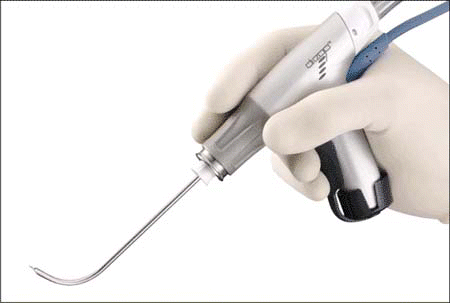Steven Pletcher, MD, Assistant Professor in the Department of Otolaryngology-Head and Neck Surgery, Division of Rhinology, at the University of California, said that the advantage of the microdebrider is that cutting and suctioning can be accomplished simultaneously with one hand. This can be helpful when performing sinus surgery, when, as Dr. Pletcher said, You’re operating in a deep cavity and you have room for only one single-handed instrument.
Explore This Issue
February 2007Microdebrider Eustachian Tuboplasty
Dr. Pletcher coauthored a study presented at the American Academy of Otolaryngology-Head and Neck Surgery meeting titled Microdebrider Eustachian Tuboplasty: A Preliminary Report. In this study, the microdebrider was used to treat patients with eustachian tube dysfunction. The patients involved in the study all had concurrent sinonasal disease and underwent endoscopic sinus surgery at the time of microdebrider eustachian tuboplasty. The authors concluded that the procedure is safe and may provide relief from symptoms of eustachian tube dysfunction. The researchers reported no surgical complications, and subjective symptoms of ear blockage improved in 70% of patients included in the study.

Dr. Pletcher concluded, We did get good results, but the patients also had sinus surgery at the same time. We didn’t have the ability to determine if it was the sinus surgery or the procedure that involved the eustachian tube specifically that made the symptoms resolve. He and his coauthors determined that further studies will be needed to make this determination.
As with others researching use of the microdebrider, Dr. Pletcher also cautions that because of the rapid removal of tissue, surgeons must be very careful about the tissue they are targeting for removal. He states that the microdebrider can remove a great deal of tissue very quickly, so the operator must be very cognizant of the location of the blade at all times and maintain a healthy respect for the risks.
Cost
Because the microdebrider has disposable parts, it can be more expensive than other surgical tools. However, Dr. Pletcher said that he feels he can operate more quickly using the microdebrider. He opined that whatever may be lost in the cost of the device itself is made up and possibly saved in time.
Dr. Pletcher has encountered no difficulties with insurance coverage of the microdebrider as an instrument in association with other procedure costs. He concluded, The cost issue is probably negligible.
Leave a Reply